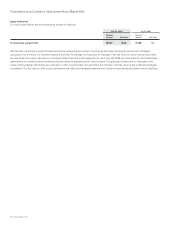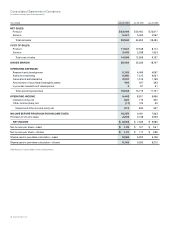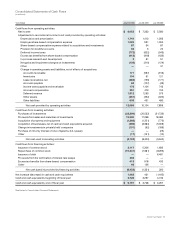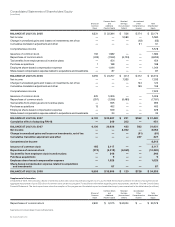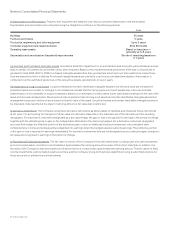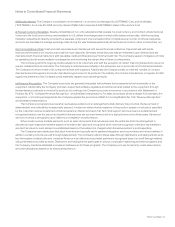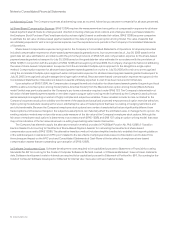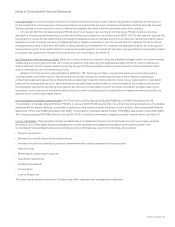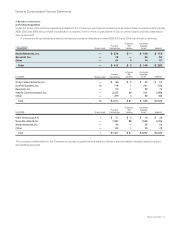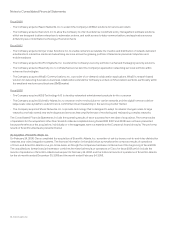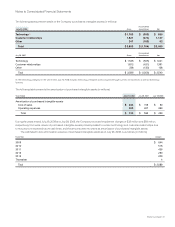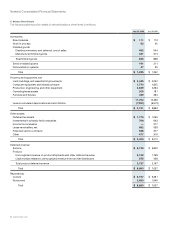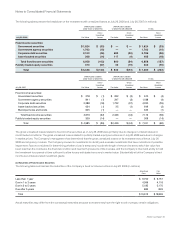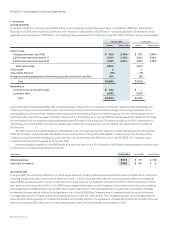Cisco 2008 Annual Report Download - page 51
Download and view the complete annual report
Please find page 51 of the 2008 Cisco annual report below. You can navigate through the pages in the report by either clicking on the pages listed below, or by using the keyword search tool below to find specific information within the annual report.
56 Cisco Systems, Inc.
Notes to Consolidated Financial Statements
(v) Recent Accounting Pronouncements
SFAS 157 In September 2006, the FASB issued SFAS No. 157, “Fair Value Measurements” (“SFAS 157”). SFAS 157 defines fair value,
establishes a framework for measuring fair value, and enhances fair value measurement disclosure. In February 2008, the FASB issued
FASB Staff Position (“FSP”) 157-1, “Application of FASB Statement No. 157 to FASB Statement No. 13 and Other Accounting Pronouncements
That Address Fair Value Measurements for Purposes of Lease Classification or Measurement under Statement 13” (“FSP 157-1”) and
FSP 157-2, “Effective Date of FASB Statement No. 157” (“FSP 157-2”). FSP 157-1 amends SFAS 157 to remove certain leasing transactions
from its scope. FSP 157-2 delays the effective date of SFAS 157 for all nonfinancial assets and nonfinancial liabilities, except for items that
are recognized or disclosed at fair value in the financial statements on a recurring basis (at least annually), until the beginning of the first
quarter of fiscal 2010. The measurement and disclosure requirements related to financial assets and financial liabilities are effective for the
Company in the first quarter of fiscal 2009. The adoption of SFAS 157 for financial assets and financial liabilities is not expected to have a
material impact on the Company’s results of operations or financial position. The Company is currently assessing the impact that SFAS 157
will have on its results of operations and financial position when it is applied to nonfinancial assets and nonfinancial liabilities beginning in
the first quarter of fiscal 2010.
SFAS 159 In February 2007, the FASB issued SFAS No. 159, “The Fair Value Option for Financial Assets and Financial Liabilities—Including
an amendment of FASB Statement No. 115” (“SFAS 159”). SFAS 159 is expected to expand the use of fair value accounting but does not
affect existing standards that require certain assets or liabilities to be carried at fair value. The objective of SFAS 159 is to improve financial
reporting by providing companies with the opportunity to mitigate volatility in reported earnings caused by measuring related assets and
liabilities differently without having to apply complex hedge accounting provisions. Under SFAS 159, a company may choose, at specified
election dates, to measure eligible items at fair value and report unrealized gains and losses on items for which the fair value option has
been elected in earnings at each subsequent reporting date. SFAS 159 is effective for the Company in the first quarter of fiscal 2009, and
it is not expected to have a material impact on the Company’s results of operations or financial position.
SFAS 141(R) and SFAS 160 In December 2007, the FASB issued SFAS No. 141 (revised 2007), “Business Combinations” (“SFAS 141(R)”)
and SFAS No. 160, “Noncontrolling Interests in Consolidated Financial Statements—an amendment of ARB No. 51” (“SFAS 160”). SFAS
141(R) will significantly change current practices regarding business combinations. Among the more significant changes, SFAS 141(R)
expands the definition of a business and a business combination; requires the acquirer to recognize the assets acquired, liabilities
assumed and noncontrolling interests (including goodwill), measured at fair value at the acquisition date; requires acquisition-related
expenses and restructuring costs to be recognized separately from the business combination; requires assets acquired and liabilities
assumed from contractual and noncontractual contingencies to be recognized at their acquisition-date fair values with subsequent
changes recognized in earnings; and requires in-process research and development to be capitalized at fair value as an indefinite-lived
intangible asset. SFAS 160 will change the accounting and reporting for minority interests, reporting them as equity separate from the
parent entity’s equity, as well as requiring expanded disclosures. SFAS 141(R) and SFAS 160 are effective for financial statements issued for
fiscal years beginning after December 15, 2008. The Company is currently assessing the impact that SFAS 141(R) and SFAS 160 will have
on its results of operations and financial position.
SFAS 161 In March 2008, the FASB issued SFAS No. 161, “Disclosures about Derivative Instruments and Hedging Activities, an amendment
of FASB Statement No. 133” (“SFAS 161”), which requires additional disclosures about the objectives of using derivative instruments; the
method by which the derivative instruments and related hedged items are accounted for under FASB Statement No.133 and its related
interpretations; and the effect of derivative instruments and related hedged items on financial position, financial performance, and cash
flows. SFAS 161 also requires disclosure of the fair values of derivative instruments and their gains and losses in a tabular format. SFAS
161 is effective for financial statements issued for fiscal years and interim periods beginning after November 15, 2008, with early adoption
encouraged. The Company is currently assessing the impact that the adoption of SFAS 161 will have on its financial statement disclosures.
(w) Reclassifications Certain reclassifications have been made to prior year balances in order to conform to the current year’s presentation.


